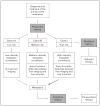Recent developments in prognostic and predictive testing in uveal melanoma
- PMID: 24713608
- PMCID: PMC4467564
- DOI: 10.1097/ICU.0000000000000051
Recent developments in prognostic and predictive testing in uveal melanoma
Abstract
Purpose of review: To provide an update on the rapidly evolving methods for assessing prognosis and predicting response to targeted molecular therapy in uveal melanoma.
Recent findings: The techniques for assessing prognosis in uveal melanoma have evolved from simple physical features, such as tumor size, location, and cell morphology, to the slightly more sophisticated counting of chromosomal gains and losses. More recently, gene expression profiling has provided a highly accurate and biologically informative gold standard for molecular prognostication. The latest step in the evolution of molecular testing has been the recent discovery of major driver mutations that allow predictive testing of response to targeted molecular therapies. Mutations in GNAQ and GNA11 are early events that promote cell proliferation, and these mutations are sensitive to MAPK kinase, PKC, and AKT inhibitors. Mutations in BAP1, SF3B1, and EIF1AX are later events that are largely mutually exclusive. Mutations in BAP1 are strongly associated with metastasis, whereas those in SF3B1 and EIF1AX are associated with good prognosis. Uveal melanomas with BAP1 mutations demonstrate sensitivity to epigenetic modulators, such as histone deacetylase inhibitors. Clinical trials are now available to evaluate the efficacy of these targeted molecular agents in patients with uveal melanoma.
Summary: Molecular prognostic testing and enrollment of high-risk patients into clinical trials of targeted molecular therapy are rapidly becoming the standard of care in the management of uveal melanoma.
Conflict of interest statement
J.W.H. is the inventor of intellectual property described in this article and receives royalties from its commercialization. He is a paid consultant for Castle Biosciences, licensee of intellectual property presented in this article. M.G.F. has no disclosures.
Figures

References
-
- Collaborative Ocular Melanoma Study Group. Assessment of metastatic disease status at death in 435 patients with large choroidal melanoma in the Collaborative Ocular Melanoma Study (COMS): COMS report no. 15. Arch Ophthalmol. 2001;199:670–676. - PubMed
-
- Augsburger JJ, Gamel JW. Clinical prognostic factors in patients with posterior uveal malignant melanoma. Cancer. 1990;66:1596–1600. - PubMed
-
- Seddon JM, Albert DM, Lavin PT, Robinson N. A prognostic factor study of disease-free interval and survival following enucleation for uveal melanoma. Arch Ophthalmol. 1983;101:1894–1899. - PubMed
-
- Finger PT 7th Edition, AJCC-UICC Ophthalmic Oncology Task Force. The 7th edition AJCC staging system for eye cancer: an international language for ophthalmic oncology. Arch Pathol Lab Med. 2009;133:1197–1198. - PubMed
-
- Harbour JW, Augsburger JJ, Char DH. Gene expression profiling versus TNM classification. Ophthalmology. 2013;120:e52–e53. - PubMed
Publication types
MeSH terms
Substances
Grants and funding
LinkOut - more resources
Full Text Sources
Other Literature Sources
Medical
Research Materials

